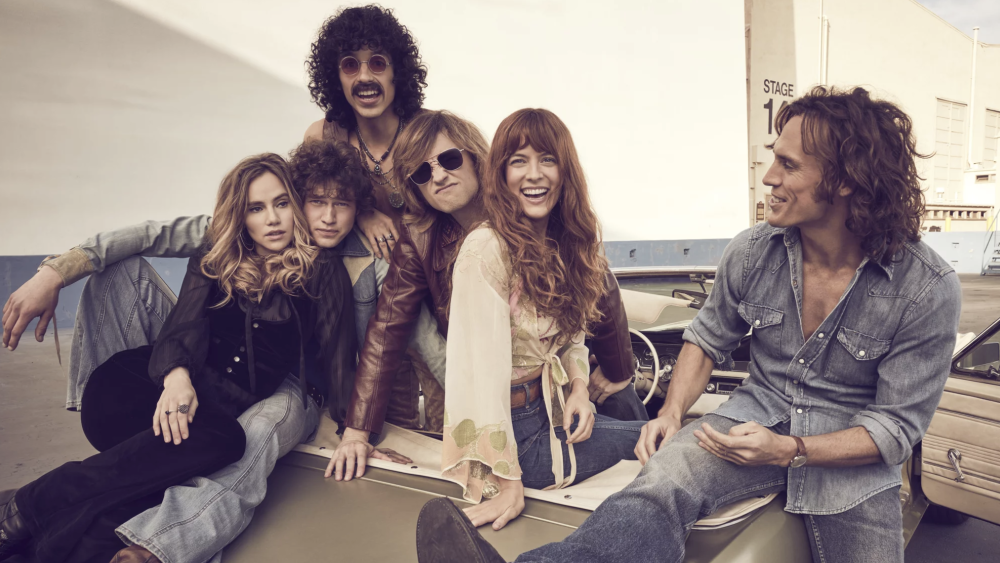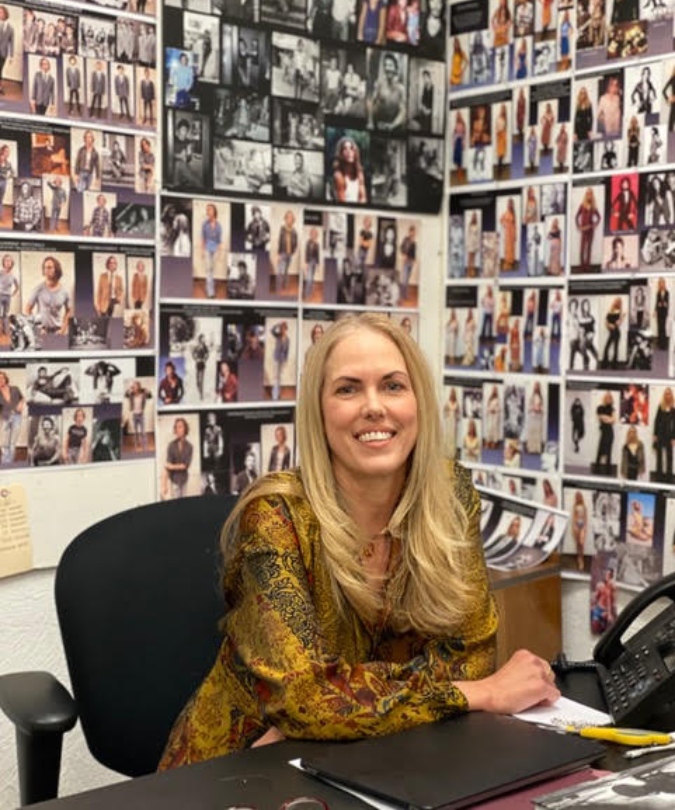
Daisy Jones & the Six whisked viewers back in time, from the late 1960s to the late 1990s, and it did so convincingly, with a Fleetwood Mac-esque vibe brought to life via the music, hair and makeup, set design, and, of course, costumes. Credit for the awesome ’70s duds – from the denim shirts to the fur coats and everything in between sported by Riley Keough, Sam Claflin, Suki Waterhouse, Tom Wright, Nabiyah Be, Camila Morrone, etc. — goes to Denise Wingate, the Daisy Jones Costume Designer whose many other credits include Melrose Place, Hall Pass, Wedding Crashers, Cruel Intentions, She’s All That, and He’s All That.
It will surprise no one that one of Wingate’s earliest jobs found her serving as a stylist on the road for a year with ’80s music icons The Bangles.
Below the Line recently caught up with Wingate for a detailed conversation in which discussed her familiarity with the Daisy Jones & the Six source material (namely Taylor Jenkins Reid’s novel of the same name), the real-life influences on her designs for the hit Amazon Prime show, and what it was like to work on He’s All That more than 20 years after She’s All That.
[Note: This interview has been edited for clarity.]

Below the Line: How and why did you get into the business?
Denise Wingate: I grew up in the San Fernando Valley in the ’70s. My parents didn’t have any money, so I was always thrift store shopping. I was always into the music scene. I had a fake I.D. when I was 14 and I would go into all the clubs in Hollywood. I moved to Hollywood when I was 16 and got a job on Melrose. I’ve always had a creative sense. I moved to New York when I was 18 and started styling. I got a job traveling with The Bangles, being their stylist. I had my foot in the music business, but also in fashion.
BTL: Who gave you your break?
Wingate: When I was 18, I was working in a clothing store on Columbus Avenue in New York. I met a stylist. She came in and said, “Hey, do you want to work as an assistant?” I worked nonstop as an assistant in New York, which is so brutal. We did photo shoots, commercials, and music videos. I worked all the time. I haven’t stopped working since I was 18.
BTL: What was drawing you to costume designing?
I never went to fashion school. I was a psychology major, so that’s why I’m interested — not in fashion per se — but in characters and why a character wears something. Everything comes down to character [and] story. That’s exciting to me. I don’t care that much about contemporary fashion. I’m more interested in the story. That’s why when I read this book, I loved it so much.
BTL: Had you read the book before this project came your way?
Wingate: I did! I was actually sent the book by our Producer, Mike Nelson. I was doing a Russell Crowe movie in New Orleans, and we were on lockdown because of a hurricane. I was in my hotel room. He said, “Why don’t you read this book and tell me what you think?” I read it in one sitting. I emailed Mike back immediately and said, “You have to get me in the room.”
BTL: Did your childhood provide a personal connection to the book?
I love this book because of where I grew up and the time. I grew up in the music business. I loved the 70s and the music, so I went all in. I spent months doing a visual representation of the book. I tried to make it as documentary-like as possible because that’s how the book read. I don’t know if you’ve read the book, but obviously, the show is like a documentary. I made it very realistic. I didn’t want it to look costume-y or people dressing up to go to a ’70s costume party, so it was a very well-documented visual representation of the book. That’s how it came about.
BTL: How much leeway did you have to play with all of that, in the sense that people read a book and they get a vision in their heads? I’m assuming you took that vision, put it down on paper, got it approved, and that’s what we see on the screen in this instance, right?
Wingate: Absolutely, yes. For the most part. Filmmaking is a team sport. I’m such a collaborator with everybody. With the producers — Hello Sunshine — they were great. They were so supportive, and the actors I worked closely with. There were things in the book that Taylor Jenkins Reid wrote, specifically how she described the costumes. I knew that the book had such a huge fanbase, and that if we didn’t stay true to those particular descriptive costumes people would be disappointed. As a fan, I expected that.
I felt like we tried to stay true to those items, those particular looks [from the book], but I worked so closely with all the actors. It was such a joy. I’ve been doing this for 30 years. This is the best project, a dream project. We became like family because of COVID, our stopping and starting. We became super close, so it was like our little Daisy Jones family.
BTL: There are all the time period changes in the show. How’d you want to portray the characters’ growth through time?
Wingate: The actors played themselves younger. That’s why hair, makeup, and wardrobe worked closely together to try to make them look younger, especially with Riley. She had a good arc. My inspiration when she was younger was a young Linda Ronstadt when she was in The Stone Poneys. She was amazing. She was a full-on rock star but wearing those short denim shorts, little halter tops, and cowboy boots. I was inspired by her. I loved Linda Ronstadt in the ’70s. I loved her early stuff, it was great. Then she morphed into more of a Stevie Nicks. It was the same thing with Cami [Morrone] who plays Camila. She was like Ali MacGraw in Love Story when she’s in Pittsburgh and looks young, then we turned her into more of a Bianca Jagger.
They were real character arcs. I found the most difficult thing for me in shooting was this cross-boarding, block shooting thing where you’re shooting different episodes in the same day. I had been doing features. The last television show I did was Melrose Place in the ’90s, so I hadn’t done television in years. This was a whole new, crazy world for me. It’s like a 10-hour movie. The going back and forth was hard to track.
BTL: Were you at tag sales and stores finding all the costumes or were you making it – or both?
Wingate: I love that you call them tag sales. I went to flea markets every single weekend — every Saturday and Sunday — for a year straight. That’s what I would do on my weekends is hit the flea markets. Luckily in Los Angeles, we have a ton of amazing costume houses, but there also happened to be three other huge ’70s movies shooting at the same time, so we were fighting for anything ’70s. People were fighting for it. Those costume houses were picked through.
We’re lucky in this day and age that we have the internet because I was buying things online. There are all these amazing vintage sites you can buy from all over the world, and Etsy. We were lucky in that I had stuff being made everywhere. I had a leathermaker. I had my longtime Seamstress, Rosa Medina, who was making beautiful pieces. It was kind of everything.
I also used new stuff if I felt that the vibe was right. Free People ended up doing a capsule collection from the show. I used a lot of their products, and they were great to work with. I don’t mind. I’m a collaborator. I used whatever felt like it was right for the show.
BTL: Including extras, how many people did you end up costuming?
Wingate: Honestly, I completely lost track. It was overwhelming. It was hard to find extras that looked like the period. When we were shooting in New Orleans, there were so many other productions going on. We were just trying to get the bodies. That was not the easiest part of the shoot, especially when we were doing the big club and concert scenes, because you want everyone to look authentic. Boy, it was a rough one, but it ended up looking good. I was stressed out about the amount of extras and how they looked. At the end of the day, I was like, “Why was I stressing out about that? You don’t see those people in the deep background so much.”
BTL: But, roughly, was it in the thousands?
Wingate: Thousands! We must have had 1,500 changes just for principals. It was just bodies at a certain point.
BTL: What’s next for you? Do you know yet, or are you stuck because of the strike and doing nothing right now?
Wingate: I am stuck not just because of the strike. When we were shooting our last episode in Greece, I broke my ankle and tore three ligaments in our costume shop, so I had to finish the show in a wheelchair. I was in a wheelchair and on crutches. I’m actually going back to Greece next month because I didn’t get to have the vacation I wanted to have at the end of the show.
Hopefully, by the time I come back, the strike will be over and we will all be back to work. Personally, I love doing this period so much that I’m hoping — because of the success of the show — somebody else wants to do another ’70s period show and thinks I’m appropriate for it. It was just a blast.
BTL: Since we still have a couple of minutes left, what was it like to work on He’s All That so many years after making She’s All That?
Wingate: It was almost exactly 20 years later. It was the weirdest thing, because myself and the producer were the only two original people. It was great, shot during COVID, and it was in town. I felt like I was the technical adviser. I’d say, “In the original movie, this is what we did.” We put Easter eggs in for that. I was, like, the old person who was there the longest.
I just love what I do, so I have fun on any show. My thing is, when you do it for so long, you just like to work with people you like. Mark Waters directed it. I’ve done four movies with him, and I love him. You spend more time on a film set — and they’re like family — than you do with your own family sometimes, so it better be with people you like.
Daisy Jones & the Six is now streaming on Prime Video.





